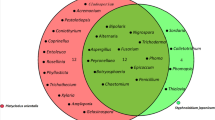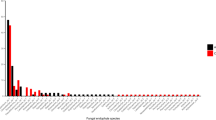Abstract
Endophytes may gradually accumulate in the new geographic range of a non-native plant, just as pathogens do. To test this hypothesis, the dynamics of colonization and diversity of foliar fungal endophytes of non-native Ageratina adenophora were investigated. Previous reports showed that the time since the initial introduction (1930s) of A. adenophora into China varied among populations. Endophytes were sampled in three provinces of Southwest China in 21 sites that varied from 20 to 70 years since the introduction of A. adenophora from its native Central America. Endophyte isolation frequencies varied from 1.87 % to 60.23 % overall in a total of 4,032 leaf fragments. Based on ITS sequence variations, 463 fungal endophytes were distinguished as 112 operational taxonomic units (OTUs) belonging to the Sordariomycetes (77 OTUs, 373 isolates), Dothideomycetes (18 OTUs, 38 isolates), and Agaricomycetes (17 OTUs, 52 strains) classes. Colletotrichum (28.51 %), Nemania (14.90 %), Phomopsis (13.17 %), and Xylaria (4.97 %) were the most abundant genera. Both endophyte diversity and overall isolation frequency increased with time since introduction. The genetic differentiation of the fungus Colletotrichum gloeosporioides indicated that the dispersal of endophytes was likely affected by a combination of geographic factors and the invasion history of the host A. adenophora.




Similar content being viewed by others
References
Arnold AE (2007) Understanding the diversity of foliar endophytic fungi: progress, challenges, and frontiers. Fungal Biol Rev 21:51–66
Arnold AE, Henk DA, Eells RL, Lutzoni F, Vilgalys R (2007) Diversity and phylogenetic affinities of foliar fungal endophytes in loblolly pine inferred by culturing and environmental PCR. Mycologia 99:185–206
Arnold AE, Herre EA (2003) Canopy cover and leaf age affect colonization by tropical fungal endophytes: ecological pattern and process in Theobroma cacao (Malvaceae). Mycologia 95:388–398
Arnold AE, Lutzoni F (2007) Diversity and host range of foliar fungal endophytes: are tropical leaves biodiversity hotspots? Ecology 88:541–549
Andonian K, Hierro JL (2011) Species interactions contribute to the success of a global plant invader. Biol Invasions 13:2957–2965
Aschehoug ET, Metlen KL, Callaway RM, Newcombe G (2012) Fungal endophytes directly increase the competitive effects of an invasive forb. Ecology 93:3–8
Callaway RM, Maron JL (2006) What have exotic plant invasions taught us over the past 20 years? Trends Ecol Evol 21:369–374
Callaway RM, Thelen GC, Rodriguez A, Holben WE (2004) Soil biota and exotic plant invasion. Nature 427:731–733
Ding J, Mack RN, Lu P, Ren M, Huang H (2008) China's booming economy is sparking and accelerating biological invasions. Bioscience 58:317–324
Duan H, Qiang S, Su X, Wu H, Zhu Y, Liu L (2005) Genetic diversity of Eupatorium adenophorum determined by AFLP marker. Acta Ecol Sin 25:2109–2114
Ehrenfeld JG (2003) Effects of exotic plant invasions on soil nutrient cycling processes. Ecosystems 6:503–523
Flory SL, Clay K (2013) Pathogen accumulation and long-term dynamics of plant invasions. J Ecol 101:607–613
Gui F, Wan F, Guo J (2009) Determination of the population genetic structure of the invasive weed Ageratina adenophora using ISSR-PCR markers. Rus J Plant Physiol 56:410–416
Higgins KL, Coley PD, Kursar TA, Arnold AE (2011) Culturing and direct PCR suggest prevalent host generalism among diverse fungal endophytes of tropical forest grasses. Mycologia 103:247–260
Huang W, Guo J, Wan F, Gao B, Xie B (2007) AFLP Analysis on genetic diversity and genetic structure of Eupatorium adenophorum populations in China. J Agric Biotechnol 15:992–1000
Hyde KD, Cai L, McKenzie EHC, Yang YL, Zhang JZ, Prihastuti H (2009) Colletotrichum: a catalogue of confusion. Fungal Divers 39:1–17
Hyde KD, Soytong K (2008) The fungal endophyte dilemma. Fungal Divers 33:163–173
Jiang H, Shi Y, Zhou Z, Yang C, Chen Y, Chen L, Yang M, Zhang H (2011) Leaf chemistry and co-occurring species interactions affecting the endophytic fungal composition of Eupatorium adenophorum. Ann Microbiol 61:655–662
Jordan NR, Larson DL, Huerd SC (2008) Soil modification by invasive plants: effects on native and invasive species of mixed-grass prairies. Biol Invasions 10:177–190
Ko Ko TW, Stephenson SL, Bahkali LH, Hyde KD (2011) From morphology to molecular biology: can we use sequence data to identify fungal endophytes? Fungal Divers 50:113–120
Li X (2004) Distribution, damage and control of Eupatorium adenophorum. Guangxi Plant Prot 17:18–19
Litchman E (2010) Invisible invaders: non-pathogenic invasive microbes in aquatic and terrestrial ecosystems. Ecol Lett 13:1560–1572
Lu P, San W, Ma K (2005) Advance in the invasive species Eupatorium adenophorum. Acta Phytoecol Sin 29:1029–1037
Müller CB, Krauss J (2005) Symbiosis between grasses and asexual fungal endophytes. Curr Opin Plant Biol 8:450–456
Newcombe G, Shipunov A, Eigenbrode SD, Raghavendra AKH, Ding H, Anderson CL, Menjivar R, Crawford M, Schwarzländer M (2009) Endophytes influence protection and growth of an invasive plant. Commun Integr Biol 2:29–31
Peakall R, Smouse PE (2006) GENALEX 6: genetic analysis in Excel. Population genetic software for teaching and research. Mol Ecol Notes 6:288–295
Porras-Alfaro A, Bayman P (2011) Hidden fungi, emergent properties: endophytes and microbiomes. Annu Rev Phytopathol 49:291–315
van der Putten WH, Klironomos JN, Wardle DA (2007) Microbial ecology of biological invasions. ISME J 1:28–37
Rudgers JA, Mattingly WB, Koslow JM (2005) Mutualistic fungus promotes plant invasion into diverse communities. Oecologia 144:463–471
Saikkonen K, Faeth SH, Helander M, Sullivan TJ (1998) Fungal endophytes: a continuum of interactions with host plants. Annu Rev Ecol Syst 29:319–343
Saikkonen K, Wali P, Helander M, Faeth SH (2004) Evolution of endophyte–plant symbioses. 2004. Trends Plant Sci 9:275–180
Spellerberg IF, Fedor PJ (2003) A tribute to clarde Shannon (1916–2001) and a plea for more rigorous use of species richness, species diversity and the ‘Shannon–Wiener’ index. Glob Ecol Biogeogr 12:177–179
Stinson KA, Campbell SA, Powell JR, Wolfe BE, Callaway RM et al (2006) Invasive plant suppresses the growth of native tree seedlings by disrupting belowground mutualisms. PLoS Biol 4(5):e140. doi:10.1371/journal.pbio.0040140
Strayer DL, Eviner VT, Jeschke JM, Pace ML (2006) Understanding the long-term effects of species invasions. Trends Ecol Evol 21:645–651
Shipunov A, Newcombe G, Raghavendra AKH, Anderson CL (2008) Hidden diversity of endophytic fungi in an invasive plant. Am J Bot 95:1096–1108
Thompson JD, Higgins DG, Gibson TJ (1994) CLUSTAL W: improving the sensitivity of progressive multiple sequence alignment through sequence weighting, positions-specific gap penalties and weight matrix choice. Nucleic Acids Res 22:4673–4680
Thrall PH, Hochberg ME, Burdon JJ, Bever JD (2006) Coevolution of symbiotic mutualists and parasites in a community context. Trends Ecol Evol 22:120–126
Vilá M, Espinar JL, Hejda M, Hulme PE, Jarošík V, Maron JL, Pergl J, Schaffner U, Sun Y, Pyšek P (2011) Ecological impacts of invasive alien plants: a meta-analysis of their effects on species, communities and ecosystems. Ecol Lett 14:702–708
Wang R, Wang Y (2006) Invasion dynamics and potential spread of the invasive alien plant species Ageratina adenophora (Asteraceae) in China. Divers Distrib 12:397–408
Wang R, Wang J-F, Qiu Z-J, Meng B, Wan F-H, Wang Y-Z (2011) Multiple mechanisms underlie rapid expansion of an invasive alien plant. New Phytol 191:828–839
Williamson M (1996) Biological invasions. Chapman and Hall, London
Weir BS, Johnston PR, Damm U (2012) The Colletotrichum gloeosporioides species complex. Stud Mycol 73:115–180
Wolfe BE, Rodgers VL, Stinson KA, Pringle A (2008) The invasive plant Alliaria petiolata (garlic mustard) inhibits ectomycorrhizal fungi in its introduced range. J Ecol 96:777–783
Wu Z, Qin G, Deng T (2006) Invasion and establishment of Eupatorium adenophorum Spreng and its risk appraisal in some areas of Guangxi. Southwest China J Agric Sci 17:469–471
Zhou S, Tang C, Hou T, Li M, Jiang H (2006) Study on the transmission of Eupatorium adenophorum. Sichuan Anim Vet Sci 5:30–31
Acknowledgments
We particularly thank three anonymous reviewers for the detailed and constructive suggestions for our paper. We also thank Huan Jiang, Zhen-Xin Zhou, Yun-Jiao Chen, Chen Yang, Yun-Tao Shi, and Li-Min Chen at Yunnan University for partially sampling, isolating, and identifying the endophytes; Susan Straight at the Center for Intercultural Education, New Mexico, USA, and Kelly Gorman, University of Victoria, Canada, for helping us with the English language. This project was financially supported by the National Basic Research Program of China (973 Program) (2013CD127500) and the National Science Foundation of China (Nos. 30960077, 31360153).
Author information
Authors and Affiliations
Corresponding author
Additional information
L. Mei and M. Zhu contributed equally to this work.
Rights and permissions
About this article
Cite this article
Mei, L., Zhu, M., Zhang, DZ. et al. Geographical and Temporal Changes of Foliar Fungal Endophytes Associated with the Invasive Plant Ageratina adenophora . Microb Ecol 67, 402–409 (2014). https://doi.org/10.1007/s00248-013-0319-8
Received:
Accepted:
Published:
Issue Date:
DOI: https://doi.org/10.1007/s00248-013-0319-8




